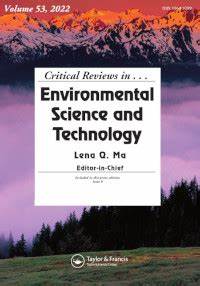Recommendations for the use of metagenomics for routine monitoring of antibiotic resistance in wastewater and impacted aquatic environments
IF 11.4
1区 环境科学与生态学
Q1 ENVIRONMENTAL SCIENCES
Critical Reviews in Environmental Science and Technology
Pub Date : 2023-03-01
DOI:10.1080/10643389.2023.2181620
引用次数: 4
Abstract
Abstract Shotgun metagenomic sequencing of the collective genomic information carried across microbial communities is emerging as a powerful approach for monitoring antibiotic resistance in environmental matrices. Metagenomics is advantageous in that known and putative antibiotic resistance genes (ARGs) (i.e., the resistome) can be screened simultaneously without a priori selection of targets. Additionally, as new ARGs are discovered and catalogued, stored sequencing data can be reanalyzed to assess the prevalence of emerging genes or pathogens. However, best practices for metagenomic data generation and processing are needed to support comparability across space and time. To support reproducible downstream analysis, guidance is first needed with respect to sampling design, sample preservation and storage, DNA extraction, library preparation, sequencing depth, and experimental controls. Here we conducted a systematic review to assess current practices for the application of metagenomics for AR profiling of wastewater, recycled water, and surface water and to offer recommendations to support comparability in the collection, production, and analysis of resulting data. Based on integrated analysis of findings and data reported across 95 articles identified, a field to benchtop metagenomic workflow is discussed for optimizing the representativeness and comparability of generated data. Through the reanalysis of 1474 publicly-available metagenomes, appropriate sequencing depths per environment and uniform normalization strategies are provided. Further, there is opportunity to harness the quantitative capacity of metagenomics more overtly through inclusion of sequencing controls. The recommendations will amplify the overall value of the metagenomic data generated to support within and between study comparisons, now and in the future. Graphical Abstract建议使用宏基因组学对废水和受影响的水生环境中的抗生素耐药性进行常规监测
霰弹枪宏基因组测序是一种通过微生物群落携带的集体基因组信息来监测环境基质中抗生素耐药性的有力方法。宏基因组学的优势在于,已知和假定的抗生素耐药基因(ARGs)(即抵抗组)可以同时筛选,而无需先验地选择靶标。此外,随着新的ARGs的发现和编目,可以重新分析存储的测序数据,以评估新出现的基因或病原体的流行程度。然而,需要元基因组数据生成和处理的最佳实践来支持跨空间和时间的可比性。为了支持可重复的下游分析,首先需要在采样设计、样品保存和储存、DNA提取、文库制备、测序深度和实验控制方面提供指导。在此,我们进行了一项系统综述,以评估目前应用宏基因组学对废水、循环水和地表水进行AR分析的实践,并提出建议,以支持收集、生产和分析结果数据的可比性。基于对95篇论文的研究结果和数据的综合分析,本文讨论了台式宏基因组工作流程,以优化生成数据的代表性和可比性。通过对1474个公开的宏基因组的再分析,提供了每个环境下合适的测序深度和统一的归一化策略。此外,通过包含测序控制,有机会更公开地利用宏基因组学的定量能力。这些建议将扩大所产生的宏基因组数据的总体价值,以支持现在和将来的研究比较内部和之间的比较。图形抽象
本文章由计算机程序翻译,如有差异,请以英文原文为准。
求助全文
约1分钟内获得全文
求助全文
来源期刊
CiteScore
27.30
自引率
1.60%
发文量
64
审稿时长
2 months
期刊介绍:
Two of the most pressing global challenges of our era involve understanding and addressing the multitude of environmental problems we face. In order to tackle them effectively, it is essential to devise logical strategies and methods for their control. Critical Reviews in Environmental Science and Technology serves as a valuable international platform for the comprehensive assessment of current knowledge across a wide range of environmental science topics.
Environmental science is a field that encompasses the intricate and fluid interactions between various scientific disciplines. These include earth and agricultural sciences, chemistry, biology, medicine, and engineering. Furthermore, new disciplines such as environmental toxicology and risk assessment have emerged in response to the increasing complexity of environmental challenges.
The purpose of Critical Reviews in Environmental Science and Technology is to provide a space for critical analysis and evaluation of existing knowledge in environmental science. By doing so, it encourages the advancement of our understanding and the development of effective solutions. This journal plays a crucial role in fostering international cooperation and collaboration in addressing the pressing environmental issues of our time.

 求助内容:
求助内容: 应助结果提醒方式:
应助结果提醒方式:


